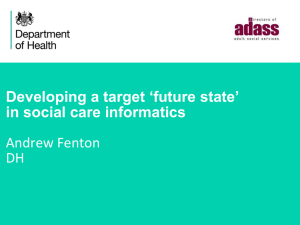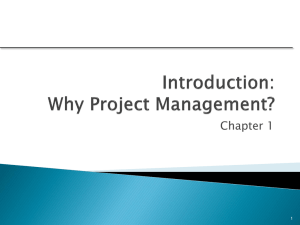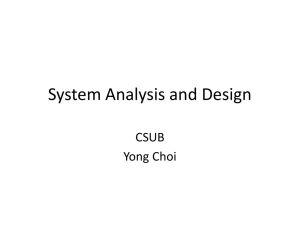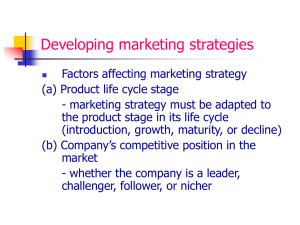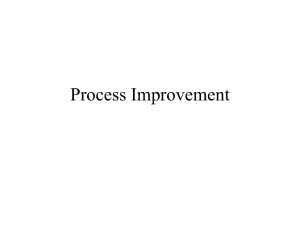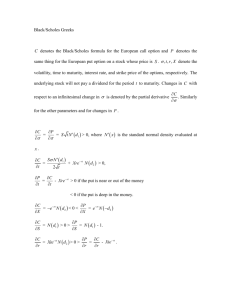Proposed Digest of Journal Articles for Public SES
advertisement
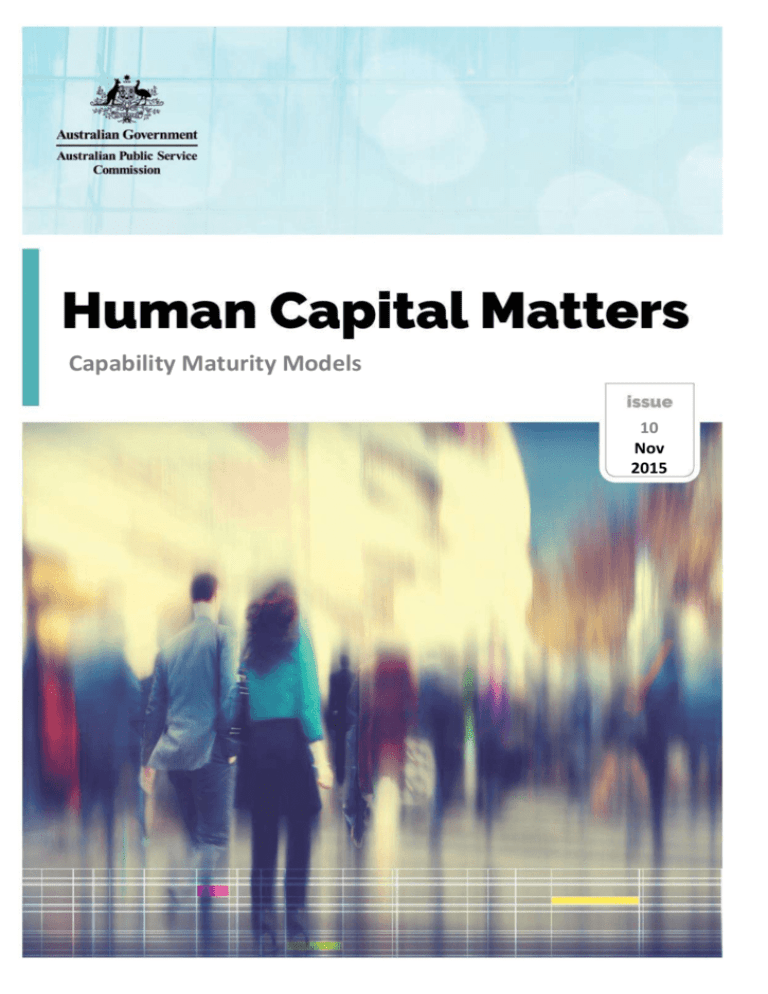
Capability Maturity Models 10 Nov 2015 APS Human Capital Matters: Capability Maturity Models December, 2015, Issue 11 Editor’s Note to Readers Welcome to the penultimate edition of Human Capital Matters (HCM) for 2015—the digest for leaders and practitioners with an interest in human capital and organisational capability. Human Capital Matters seeks to provide Australian Public Service leaders and practitioners with easy access to the issues of contemporary importance in public and private sector human capital and organisational capability. It has been designed to provide interested readers with a monthly guide to the national and international ideas that are shaping human capital thinking and practice. The inclusion of articles is aimed at stimulating creative and innovative thinking and does not in any way imply that the Australian Public Service Commission endorses service providers or policies. Thank you to those who took the time to provide feedback on earlier editions of Human Capital Matters. Comments, suggestions or questions regarding this publication are always welcome and should be addressed to: humancapitalmatters@apsc.gov.au. Readers can also subscribe to the mailing list through this email address. This edition reviews available material on Capability Maturity Models (CMM). The review started from the premise posited by Schmidtchen and Cotton in their paper to the Australian and New Zealand Academy of Management (ANZAM) in 2014: Business process management is central to organisational capability and organisations need to build, maintain, and continuously improve their organisational capability. Central to this is the ability to accurately assess organisational capability. A common mechanism for this is through the use of a maturity model CMM were originally developed as tools for objective assessment of software implementation. It is derived from work described by Watts Humphrey in 1989, based on his career with IBM. Though developed for the field of software development, CMM can also be used to aid other business processes. The term ‘maturity’ refers to the degree of formality and optimisation of processes—from ad hoc through formally defined steps and metrics, to active optimisation of processes. A maturity model can be thought of as a set of structured levels that describe how likely the behaviours, practices and processes of an organisation can reliably and sustainably produce required outcomes. CMM can be used as a benchmark for comparison purposes. List of articles: The first article is the seminal paper by Paulk, Curtis, Chrissis and Weber from 1993 which draws on the original work by Humphrey. The authors believe that the ‘simple’ maturity questionnaire originally developed by Humphrey was intended to help organisations identify how their (software) processes might be improved and that a structured review of processes, beyond just the questionnaire, also offered an opportunity to explore process maturity 2 The second article is the paper presented by Schmidtchen and Cotton in 2014. The paper describes the application of a business process maturity model in the Australian Public Service (APS) and outlines its use for comparative purposes. It provides comment on the applications and limitations of maturity models. The third article by Rölinger, Pöppelbuß and Becker discusses the limitations of CMM. These limitations are discussed by Schmidtchen and Cotton to explore a CMM for the APS. The fourth article by McCormack and others investigates turning points in the maturation process. The paper provides quantitative evidence of the critical maturity components associated with each level of maturity. The fifth article is the Administrative and Support Services Benchmarking Report for 2012/13 from the New Zealand Treasury. This paper is included to demonstrate the internal benchmarking properties afforded by comparisons over time according to a structured framework such as a capability maturity model. 3 Paulk, M. C., Curtis B., Chrissis, M.B. & Weber, C.V. Capability Maturity Model for Software, Version 1.1 Software Engineering Institute, Pennsylvania, USA, 1993 The book by Paulk et al is about software development processes and provides the original thinking behind the development of capability maturity models for other business processes. In the five chapters of the book the authors define and describe: the concepts necessary to understand the CMM and the motivation and purpose of the CMM; the five levels of the model and the principles that underlie them; how the model is structured into key process areas, organised by common features and key practices; a high-level overview of how the model provides guidance for software process assessments, capability evaluations and process improvements; and finally, the book concludes with possible future directions for the CMM and related products. This technical report was produced for the SEI Joint Program Office, ESC/AVS Hanscomb AFB, MA and was funded by the U.S. Department of Defense Return to list of articles Schmidtchen, D. & Cotton, T. Comparative application of a business process maturity model in the public sector. Paper presented to the 28th Australian and New Zealand Academy of Management in 2014 According to Schmidtchen and Cotton, organisational capability in the APS has been defined as the combination of people, processes, systems, structures and culture that contribute to continuously improving performance in APS departments and agencies. The paper focuses on the use of a maturity model as a comparative tool within the APS. Two methods of assessing capability have been used in the APS since 2010. The interdependent methods are firstly, the capability review model which focuses on leadership, strategic and delivery capabilities. The second and complementary method is the CMM in which APS agencies use a standard maturity model to assess a range of organisational capabilities such as stakeholder engagement, strategic planning, risk management, change management, workforce planning and performance management. The first method requires a team of independent assessors on-site for an extended period. The second requires an agency to make two self-assessments: the agency’s current maturity status against specified capabilities and secondly, its required (or perhaps aspirational) status in regard to the same target capabilities. The assessments are provided by way of a survey delivered as part of the State of the Service annual census of APS agencies. In the second method, the CMM method, the targeted APS agencies rate their current and required capabilities in a maturity model structure of five levels from ad hoc (immature) to optimised (mature). The levels are hierarchical. Progression from immature to mature is seen as an evolutionary progression through: awareness (immature); general acceptance (defined by tools and databases); managed (with a more centralised, strategic approach); to finally, regular integration of lessons learned and feedback loops resulting in measurable benefits (mature). The authors define APS agencies by five functional types: policy, large operational, small operational, regulatory and specialist. Capabilities for functional groups can be compared within and against other functional types though the critical measurements are the gaps between current and 4 required capabilities for individual agencies. In this way agencies are able to see increases in current and required capabilities over time and, a reduction in the capability gap over time. As stated in the discussion: By comparing current capability over time, an assessment of whether agency capability has actually ‘matured’; that is, has increased, can be made; this allows agencies to evaluate the progress of earlier capability investments. By comparing their required level of capability maturity over time, agencies are able to identify how their changing business context has influenced their capability requirements; it assists agencies make a critical assessment of their likely future business and what this means for investment decisions in their business processes More importantly, by examining the gap between current and future requirements, agencies can determine where they might most profitably invest their resources to improve capability across their business processes. This assumes a different view of ‘maturity’ in that business process maturity is not affected by simple constant improvement, but rather by accurately assessing business needs and matching business process maturity to actual business need. This then allows agencies to evaluate how effective their efforts have been at improving their business processes where the need is greatest. When looked at across an industry, in this case the APS, it assists in identifying systemic areas of weakness to which resources can be allocated with greatest effect – in the APS one area where this can be seen is in the workforce planning capability While the authors note the limitations of CMM (which will be discussed in the next abstract) they conclude that the CMM offers insights into organisational capability, especially when capability is tracked over time. At the time of this paper both authors were employed by the Australian Public Service Commission, Commonwealth of Australia Canberra, Australia. Dr David Schmidtchen is the corresponding author Return to list of articles Rölinger M, Pöppelbuß J, & Becker J (2012) Maturity models in business process management, Business Process Management Journal, 18(2): 328–46. Rölinger, Pöppelbuß and Becker reviewed the research community’s criticism of maturity models on the basis that ‘scholars struggle with the conceptual enhancement of maturity models’. They note that the ‘basic purpose of maturity models is to outline the stages of maturation paths’ which can be applied for descriptive, prescriptive and comparative purposes. It is descriptive when describing an ‘as-is’ or current status/assessment. It is prescriptive ‘if it indicates how to identify desirable future maturity levels and provides guidance on how to implement improvement measures’. It serves a comparative purpose if it allows for internal and external benchmarking. Criticisms (summarised by Schmidtchen and Cotton) include technical issues such as a lack of validation in the development of the models (Wendler, 2012), limited guidance to improve performance (Becker et al., 2009; Iversen et al., 1999), and step-by-step process ‘recipes’ that lack a 5 robust empirical foundation (Benbasat et al., 1984; King and Kraemer, 1984; de Bruin et al., 2005; McCormack et al., 2009). Maturity models are seen to offer a highly prescriptive improvement path that neglects alternative approaches (Teo and King, 1997). They provide only a narrow definition of business process factors that ignore internal or external forces that might influence process improvement (Mettler and Rohner, 2009). Others have suggested that they focus on a predefined ‘end state’ instead of the factors that actually influence evolution and change through to the application (King and Kraemer, 1984). There has also been consistent concern over the non-reflective application of maturity models as a substitute for engagement with the issues associated with business process improvement (Becker et al., 2009, 2010; Iversen et al., 1999). Rölinger, Pöppelbuß and Becker analysed a sample of business process management maturity models and found that while they adequately addressed the basic development and descriptive design principles, the criteria for prescriptive use were rarely met. Consequently, the models provided limited guidance for implementing improvement measures. This article has additional value for those readers who wish to consider the differences between business process management models (BPM) and process maturity models—a distinction that lacks clarity, even in the academic literature. Rölinger, Pöppelbuß and Becker argue that more clarity is needed concerning the concepts or entities that are the subject of the assessment models. Dr Maximilian Rölinger (corresponding author) FIM Research Center Finance and Information Management, University of Augsburg, Germany. Jens Pöppelbuß, European Research Center for Information Systems, University of Münster, Germany. Professor Dr Jörg Becker, European Center for Information Systems, University of Münster, Germany Return to list of articles McCormack K, Willems J, van den Bergh J, Deschoolmeester D, Willaert P, Indihar Štemberger M,Škrinjar R, Trkman P, Ladeira M B, Valadares de Oliveira M P, Vuksic V B & Vlahovic N,(2009) A global investigation of key turning points in business process maturity, Business Process Management Journal, 15(5): 792–815. This research focuses on improving the quality of maturity models for managers. Specifically, the authors invite teams and leaders to use suggested guide-posts, milestones and measures to help address their current level of capability maturity and how they might proceed to the next level. Key turning points are conceptualised by the authors as components of business process management (BPM) that become stable and lead to the next maturity level. McCormack et al provide definitions for four stages of organisational maturity similar to those already posited: ad hoc, defined, linked and integrated. Linked is seen as the ‘breakthrough’ level of maturity in which managers employ process management with strategic intent and a view to results. The basic components of the model are: Process view in which steps, activities and tasks are documented in formats that allow people across the organisation to communicate using the same vocabulary. There is broad understanding of the processes across the organisation 6 Process jobs which require horizontal rather than vertical responsibility for which people participate and take ownership Process measurement and management systems which include measurement systems, rewards for process improvement, outcome measurements, customer-driven and team-driven measures and rewards These are supported by process structure components which are designed to break down functional compartments and which include horizontal teams and shared ownership. They are also supported by customer-focused process values, and beliefs which ‘energise’ the organisation. The key turning points for transition to higher levels are, in order of transition from lower to higher levels of maturity: The customer needs and preferences are known Teamwork and multi-skilling are endorsed Process measurement and management are defined Process metrics are used consistently Job roles have been expanded to allow insight about links to outcomes Process measures and management are accompanied by training and learning Integration and the underlying ‘process-oriented culture’ are evident through everyday use of common process language (e.g., input, output, process) Finally, at the highest levels, process analytics and automated processes are important Kevin McCormack, DRK Research, Raleigh, North Carolina, USA. Willems, van den Bergh, Deschoolmeester and Willaert, Vlerick Leuven Ghent Management School, Ghent, Belgium. Stemberger, Skrinjar and Trkman, Faculty of Economics, University of Ljubljana, Slovenia. Ladeira and de Oliveira, Departmento de Ciencias Administrativas, CEPEAD, Universidade Federal de Minas Gerais, Belo Horizonte, Brazil. Vuksic and Vlahovic, Faculty of Economics and Business, University of Agreb, Zagreb, Croatia Return to list of articles The Treasury New Zealand, Administrative & Support Services Benchmarking Report for the Financial Year 2012/13 This is the fourth annual Benchmarking of Administrative & Support Services (BASS) Benchmarking Report provided by the New Zealand Treasury. A BASS report for 2015 exists though the 2014 report goes into more detail about the use of a capability maturity models. Capability maturity models are provided for each of: Human Resources; Finance; Procurement; Communications; and, Legal. Each is described according to progressive maturity levels: lagging, achieving, exceeding and leading. In this report and similar reports for the three previous annual reports, capability maturity is only one metric used. Metric descriptions for each function were originally based on the UK Audit Agencies but have been refined so that they are now based on a range of international benchmarking best practices. These include The Hackett Group, APQC and the Australian NSW ICT Benchmarking. 7 Each function is assessed against a range of metrics which include current and future aspiration capability maturity. For example, for HR, eight metric definitions include two for HR CMM (current and aspirational): capability maturity score for ten selected leading HR practices undertaken by the function are averaged (1-4: lagging achieving, exceeding and leading) across the ten questions. The same process of selecting 10 leading practices (and associated questions and average of four-point score) within the function is applied to all functions, except ICT. Using HR again as an example, the descriptions of the 10 leading practices assessed by way of CMM (on the four-point scale) are: Ref Category Capability element description 1 capability developing people skills of managers 2 operations strategic workforce planning (SWP) reporting and analytics 3 4 5 operations operations operations performance management rewards strategy staff engagement 6 resources staff technology capability and process improvement skills 7 strategy SWP data and capability 8 strategy executive leadership in governance 9 strategy linkage of HR policies and practices to broader HR/Business goals 10 technology automation and self-service delivery To contrast and demonstrate the fit-for-purpose nature of the NZ capability maturity models used in the public sector, the Procurement CMM is shown below: Ref Category Capability element description 1 Influence the profile of procurement in the organisation 2 supplier management outcome focus supplier relationship management 3 4 5 influence people procurement strategy alignment with agency key result areas procurement function engage with agency stakeholders management of people and skills development 6 governance governance and organisation of the procurement function 7 suppliers sourcing and collaboration 8 technology use of technology processes and tools 8 9 people knowledge and performance management 10 governance alignment with policy and processes 9


